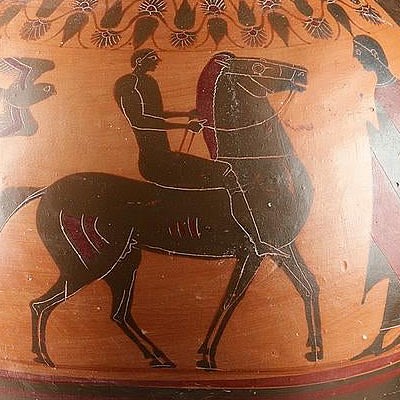Roman / Byzantine Marble Ossuary - Cherubs, Acanthus
Lot 80a
About Seller
Artemis Fine Arts
686 S Taylor Ave, Ste 106
Louisville, CO 80027
United States
Selling antiquities, ancient and ethnographic art online since 1993, Artemis Gallery specializes in Classical Antiquities (Egyptian, Greek, Roman, Near Eastern), Asian, Pre-Columbian, African / Tribal / Oceanographic art. Our extensive inventory includes pottery, stone, metal, wood, glass and textil...Read more
Categories
Estimate:
$6,000 - $8,000
Absentee vs Live bid
Two ways to bid:
- Leave a max absentee bid and the platform will bid on your behalf up to your maximum bid during the live auction.
- Bid live during the auction and your bids will be submitted real-time to the auctioneer.
Bid Increments
| Price | Bid Increment |
|---|---|
| $0 | $25 |
| $300 | $50 |
| $1,000 | $100 |
| $2,000 | $250 |
| $5,000 | $500 |
| $10,000 | $1,000 |
| $20,000 | $2,500 |
| $50,000 | $5,000 |
| $100,000 | $10,000 |
| $200,000 | $20,000 |
About Auction
By Artemis Fine Arts
Jun 4, 2020
Set Reminder
2020-06-04 10:00:00
2020-06-04 10:00:00
America/New_York
Bidsquare
Bidsquare : Exceptional Antiquities, Asian, Ethnographic
https://www.bidsquare.com/auctions/artemis-gallery/exceptional-antiquities-asian-ethnographic-5185
An important one-day auction featuring museum-worthy examples of Egyptian, Greek, Roman, Etruscan, Near Eastern, Far East / Asian, Pre-Columbian, African / Tribal, Oceanic, Native American, Spanish Colonial, Russian, Fossils, Ancient Jewelry, Fine Art, so much more! Artemis Fine Arts info@artemisgallery.com
An important one-day auction featuring museum-worthy examples of Egyptian, Greek, Roman, Etruscan, Near Eastern, Far East / Asian, Pre-Columbian, African / Tribal, Oceanic, Native American, Spanish Colonial, Russian, Fossils, Ancient Jewelry, Fine Art, so much more! Artemis Fine Arts info@artemisgallery.com
- Lot Description
Late Roman / Early Byzantine Period, ca. 5th to 7th century CE. A handsome marble casket, rectangular in profile and carved to serve as an ossuary. The exterior front is decorated with a motif of two cherub or putti heads, each nestled in the curve of a large vine swag with acanthus leaves at the corners and the center; this pattern (minus the cherub heads) continues onto the sides. Marks on the interior show the use of stonemasons' tools, allowing us to visualize how this item was made. A lower lip around the base provides stability. Size: 12" L x 20.2" W x 12.3" H (30.5 cm x 51.3 cm x 31.2 cm)
Romans who lived in the eastern part of the empire - especially Jewish people in the Holy Land - commonly used ossuaries instead of large stone sarcophagi, and this casket likely comes from that region. The carved artwork on its face connects it to Roman themes - the cherubs, acanthus leaves, and vines were all important symbols associated with Roman funerary rituals.
Provenance: private J.H. collection, Beaverton, Oregon, USA, acquired in May 2014; ex-Arte Primitivo Gallery, New York, New York, USA (auction #70, May 15, 2014, lot 359); ex-private Florida, USA collection, acquired in the 1990s; ex-private old New York, USA collection
All items legal to buy/sell under U.S. Statute covering cultural patrimony Code 2600, CHAPTER 14, and are guaranteed to be as described or your money back.
A Certificate of Authenticity will accompany all winning bids.
We ship worldwide and handle all shipping in-house for your convenience.
#149607One side has been expertly repaired/restored from plaster; this is approximately 40% of the piece, but is not visible when viewed from the front. The restored side simply looks like one side of the piece is heavily weathered. The unrestored areas feature small fissures that do not threaten the stability of the piece. Rich deposits on surface and the artwork on the front and sides are nicely preserved.Condition
- Shipping Info
-
All shipping is handled in-house for your convenience. Your invoice from Artemis Gallery will include shipping calculation instructions. If in doubt, please inquire BEFORE bidding for estimated shipping costs for individual items.
-
- Buyer's Premium



 EUR
EUR CAD
CAD AUD
AUD GBP
GBP MXN
MXN HKD
HKD CNY
CNY MYR
MYR SEK
SEK SGD
SGD CHF
CHF THB
THB














